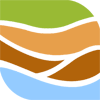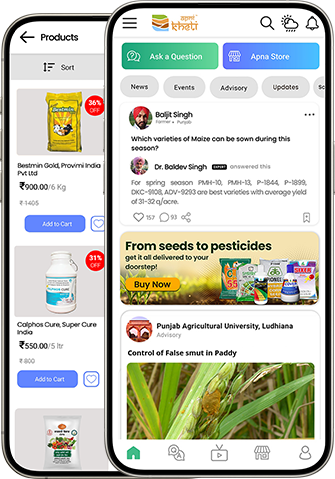.jpg) • Colibacillosis: Firstly the diarrhea occurs and then sudden death of animal.
• Colibacillosis: Firstly the diarrhea occurs and then sudden death of animal.
Treatment: Fluid therapy or antibiotics are given to the animal to cure this disease.
.jpg) • Coccidiosis: The diarrhea occurs to the 10-21 days old infant.
• Coccidiosis: The diarrhea occurs to the 10-21 days old infant.
Treatment: Fluid therapy or coccidiostats is given to cure form disease.
(2).png) • Starvation (hypoglycaemia): Firstly the weakness occurs and then death of animal.
• Starvation (hypoglycaemia): Firstly the weakness occurs and then death of animal.
Treatment: Dextrose solutions or supplementary feeding is given to cure the disease.
.jpg) • Exudative epidermitis: The skin lesions occur on the body which results in death.
• Exudative epidermitis: The skin lesions occur on the body which results in death.
Treatment: The antibiotics such as skin protectants and vitamins are given to get relief from disease.
.jpg) • Respiratory disease: Sneezing, coughing and reduced growth are the symptoms of disease and sometimes death occurs.
• Respiratory disease: Sneezing, coughing and reduced growth are the symptoms of disease and sometimes death occurs.
Treatment: By giving suitable antibiotics or by improving ventilation helps to cure the disease.
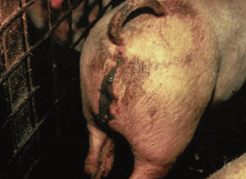 • Swine dysentery: In this disease diarrhea occurs with blood or diarrhea or growth rate reduces and ultimately death of animal.
• Swine dysentery: In this disease diarrhea occurs with blood or diarrhea or growth rate reduces and ultimately death of animal.
Treatment: Reduced stocking density helps to control swine dysentery.
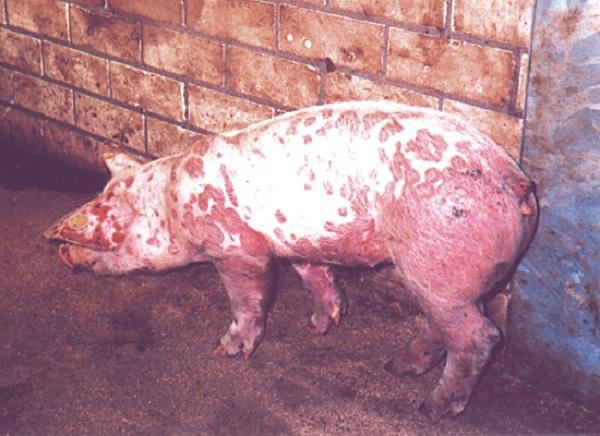 • Proliferative enteropathy: In this disease diarrhea occurs with blood or diarrhea or growth rate reduces and ultimately sudden death of animal.
• Proliferative enteropathy: In this disease diarrhea occurs with blood or diarrhea or growth rate reduces and ultimately sudden death of animal.
Treatment: Iron or vitamin doses are given to cure proliferative enteropathy.
.jpg) • Sarcoptic mange: The signs of this disease are itching, scratching, rubbing and reduced growth rate.
• Sarcoptic mange: The signs of this disease are itching, scratching, rubbing and reduced growth rate.
Treatment: Miticidal sprays or injections are given to cure disease.
• Intestinal torsion: It results in sudden death of animal.
Treatment: Manipulation of diet will help to get rid of this disease.
• Internal pesticides (worms): In this disease diarrhea occurs or reduced growth or pneumonia occurs.
Treatment: The pesticides are given through feed or injection which helps to cure disease.
• Leptospirosis: The disease causes weak born pigs or abortions.
Treatment: Inject streptomycin @25mg/kg to the weaner pigs to get rid of leptospirosis.
• Farrowing sickness: the signs of this disease are reduced in milk production, loss of appetite and increased body temperature.
Treatment: Oxytoxin or inflammatory drugs are given to the animal to cure from disease.
(1).jpg) • Lameness: The disease results in reduced herd fertility and premature culling.
• Lameness: The disease results in reduced herd fertility and premature culling.
Treatment: No serious treatment is found but it can be prevented by preventing injuries.
• Vaginal discharge syndrome: The disease mainly causes the infections in reproductive tract.
Treatment: Antibiotic treatment of Boar’s prepuce is given to cure from this disease.
• Bladder/kidney infection: blood stained urine will come is the first symptom of this disease and then sudden death is seen.
Treatment: Antibiotic treatment of Boar’s prepuce is given to cure from this disease.
.jpg) • Erysipelas: The disease causes reproductive failure or abortions.
• Erysipelas: The disease causes reproductive failure or abortions.
Treatment: Injection of penicillin @1ml/10kg body weight is given to cure erysipelas. Continue injections for 3-4 days until disease gets cure.
• Gastric ulcers: The disease causes vomiting, loss of appetite, blood in dung which results to sudden death.
Treatment: Extra dose of Vitamin E is given in the feed for 2 months to get cure from gastric ulcers.
.jpg) • PSS (Porcine stress syndrome): It is also known as malignant hyperthermia. The symptoms are sweating, partly dead, tachycardia, arrhythmias and pyrexia.
• PSS (Porcine stress syndrome): It is also known as malignant hyperthermia. The symptoms are sweating, partly dead, tachycardia, arrhythmias and pyrexia.
Treatment: Dantrolene Sodium treatment under anesthesia is an effective treatment.

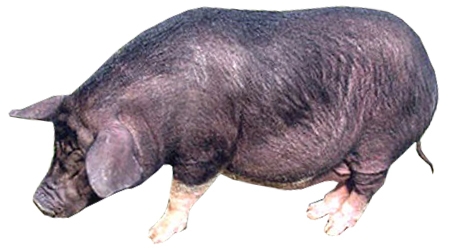
.jpg)
.jpg)
(2).png)
.jpg)
.jpg)


.jpg)
(1).jpg)
.jpg)
.jpg)


